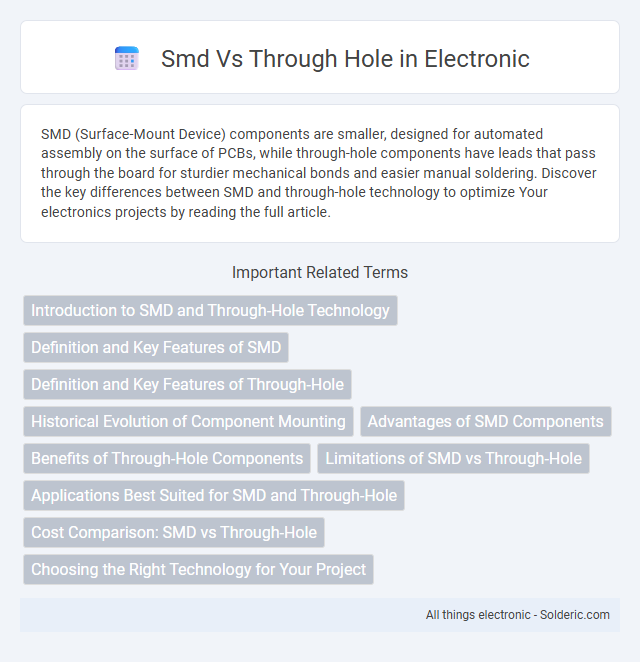SMD (Surface-Mount Device) components are smaller, designed for automated assembly on the surface of PCBs, while through-hole components have leads that pass through the board for sturdier mechanical bonds and easier manual soldering. Discover the key differences between SMD and through-hole technology to optimize Your electronics projects by reading the full article.
Comparison Table
| Feature | SMD (Surface-Mount Device) | Through-Hole |
|---|---|---|
| Mounting Technique | Mounted directly onto the PCB surface | Component leads inserted into drilled holes |
| Size | Smaller, compact design | Larger, bulkier components |
| Assembly | Automated pick-and-place machines | Often manual or wave soldering |
| Mechanical Strength | Lower mechanical strength | Higher mechanical durability |
| Electrical Performance | Better high-frequency performance | Good for high power, lower frequency |
| Cost | Lower manufacturing cost for mass production | Higher cost due to manual labor |
| Repair and Prototyping | Harder to repair or replace | Easier to solder, repair, and modify |
| Applications | Modern electronics, smartphones, laptops | Military, aerospace, high-reliability circuits |
Introduction to SMD and Through-Hole Technology
Surface-mount device (SMD) technology involves mounting electronic components directly onto the surface of printed circuit boards (PCBs), enabling higher component density and automated assembly processes. Through-hole technology requires inserting component leads into drilled holes on the PCB, providing stronger mechanical bonds and better durability for high-stress applications. SMD is favored for compact, high-speed electronics, while through-hole remains essential for prototypes and rugged environments.
Definition and Key Features of SMD
Surface-Mount Devices (SMD) are electronic components designed for direct mounting onto the surface of printed circuit boards (PCBs), contrasting with through-hole components which require leads to be inserted into drilled holes. Key features of SMD include smaller size, lightweight design, and the ability to support higher circuit densities, enabling more compact and efficient electronic assemblies. Your choice of SMD can enhance manufacturing speed and improve performance in modern electronic applications due to automated placement and soldering processes.
Definition and Key Features of Through-Hole
Through-hole technology involves mounting electronic components by inserting their leads into pre-drilled holes on a printed circuit board (PCB) and soldering them on the opposite side, ensuring strong mechanical bonds and reliable electrical connections. This method is ideal for components that require high durability, thermal resistance, and mechanical strength, such as connectors, transformers, and large capacitors. Your choice of through-hole components offers advantages in prototyping and repairability, especially in applications subjected to physical stress or mechanical strain.
Historical Evolution of Component Mounting
The historical evolution of component mounting began with through-hole technology, which involved inserting leads into drilled holes on a circuit board for manual soldering, providing strong mechanical bonds essential for early, larger electronic components. Surface-mount device (SMD) technology emerged in the 1980s as miniaturization demands increased, allowing components to be directly placed and soldered onto the PCB surface, enabling higher component density and automation. Your modern electronics rely heavily on SMD for compactness and efficiency, though through-hole components remain in use for applications requiring robust mechanical strength.
Advantages of SMD Components
SMD components offer advantages such as smaller size, enabling higher circuit densities and more compact electronic devices. Their automated assembly process improves manufacturing speed and reduces labor costs, enhancing overall production efficiency. You benefit from increased reliability and better electrical performance due to shorter lead lengths and optimized placement on printed circuit boards.
Benefits of Through-Hole Components
Through-hole components offer superior mechanical strength and reliability, making them ideal for applications subject to high stress or vibration. Their ease of manual soldering and inspection provides advantages in prototyping and repairs. Through-hole technology also supports higher power handling and improved heat dissipation compared to surface-mount devices (SMD).
Limitations of SMD vs Through-Hole
SMD (Surface-Mount Device) components face limitations in handling high power and heat dissipation compared to through-hole technology, which offers superior mechanical strength and reliability for heavy or high-stress applications. Through-hole components provide better durability in environments subject to mechanical vibration or thermal cycling, making them preferred for aerospace and military uses. The smaller size of SMDs hampers their use in applications requiring robust physical connections or easy manual soldering and repair.
Applications Best Suited for SMD and Through-Hole
SMD (Surface-Mount Device) components are best suited for high-density applications such as smartphones, laptops, and other compact electronics where space-saving and automated assembly are critical. Through-hole components excel in applications requiring mechanical strength and durability, like power supplies, automotive electronics, and connectors, where components must withstand physical stress and heat. Your choice depends on the specific needs of the project, balancing factors like size, reliability, and manufacturing complexity.
Cost Comparison: SMD vs Through-Hole
Surface-mount devices (SMD) generally offer a lower cost per unit compared to through-hole components due to automated assembly processes and reduced material usage. Through-hole components tend to incur higher labor and manufacturing expenses because of manual insertion and larger PCB space requirements, making them less cost-effective for large-scale production. Your choice between SMD and through-hole impacts overall project budgeting, especially in high-volume applications where cost efficiency is critical.
Choosing the Right Technology for Your Project
Selecting between SMD (Surface-Mount Device) and through-hole technology depends on factors like board space, production volume, and mechanical durability. SMD components offer smaller footprints and higher assembly speeds, ideal for compact, high-density PCBs and automated manufacturing. Through-hole components provide stronger mechanical bonds, beneficial for prototypes, high-stress applications, or when manual assembly and rework are common.
smd vs through hole Infographic

 solderic.com
solderic.com